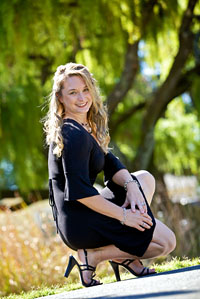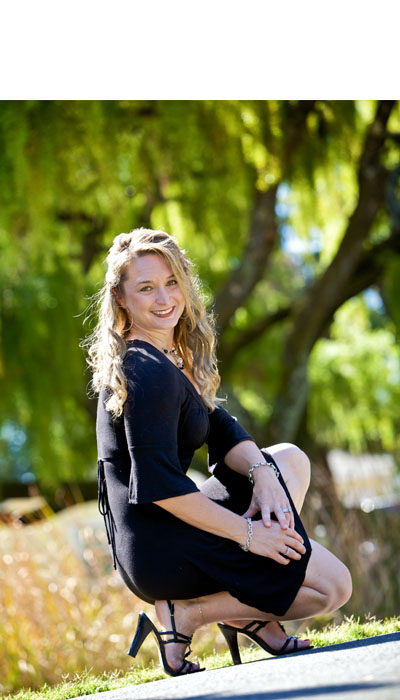Backlit portraits can be dramatic and beautiful, especially if you know how to set up your camera. In this show, I explain three sure-fire techniques for great backlit portraits.
The normal progression I go through when working outside with these types of shots is this:
- First, I position the model with the sun shining on her hair, then take a few test shots. This helps me evaluate the lighting.
- Then I switch to spot meter mode and take an exposure reading off her face.
- I'll often try adding light via reflectors or using natural reflection from the surroundings.
- If none of these techniques work the way I want, I'll then use fill flash. I might use fill flash also if I'm covering an event and have to work quickly.
The sample you see here uses the walkway to bounce light up into the model's face. She is kneeling down to be closer to the reflected surface, and to add variety to the poses we experimented with during the shoot.
Photo by Derrick Story using a Canon 5D Mark II with a 70-200mm f/2.8 L IS zoom lens.
Listen to the Podcast You can also download the podcast here (21 minutes). Or better yet, subscribe to the podcast in iTunes. Monthly Photo Assignment Simple is the Sept. 2009 Photo Assignment. My original thought was the power that comes from a simple composition, with as few elements as possible. But you might find another twist on this month's theme. You can read more about how to submit on our Member Participation page. Deadline for entry is Sept. 30, 2009. More Ways to Participate Want to share photos and talk with other members in our virtual camera club? Check out our Flickr Public Group. It's a blast! - SiteGrinder lets you take ownership of your websites. Effortlessly output pages right from Photoshop. Red River Paper -- Try the $7.99 Sample Kit. Add Magic to Your Slideshows -- FotoMagico presentations are so amazing that your audience will be asking how you did it. Technorati Tags:
digital photography, podcast, technique, Technology, The Digital Story, tips
Podcast Sponsors














Good job Derrick. I really liked this episode. Hopefully you'll do more shows on lighting in the future.
Thanks Stephen. Yes, I will continue to keep the "how to" podcasts in the mix. Next week we have an interview, however, that I think you will also enjoy. Stay tuned.
Now, the real way to shoot backlit portraits.
1. Position the sun behind the model so it highlights her hair. (he got that part right).
2. Take an incident, not a spot, unless you remember that skin is Zone VI instead of Zone V, which all meters are calibrated for, reading on the subject's face and stop down one stop to prevent the background from being blown out.
3. Set up a flash, preferably off camera, and set it to the setting of the incident minus one stop for a strong fill, and two stops for a softer fill. Make sure you don't exceed your camera's flash synch speed!
4. If you do this correctly, there will be no need to shoot a bunch of test shots, because you will have nailed it. Although it is not the best way to do it, if you have a flash with TTL, then put it on automatic and let a machine do all the thinking for you.
Personally, I think the camera should be used to actually record the image. The photographer should be the one doing the thinking, but what do I know, I have only been doing this for about 30 years. Digital has turned people into spectators rather than photographers. Which is why I only use digital to shoot casual stuff and never critical stuff. That is done on film, and in medium format (Hasselblad)
I find the last comment a little condescending. Not everyone who reads this blog is a professional earning enough money to own or pay off expensive equipment, let alone paying for the purchasing and the developing of film. Many youngsters these days are our future professional photographers in the making, those who on being given a digital camera (because unfortunately this is the age of technology) will discover a passion for light and capture. We are all 'spectators' of life, it is how we see it that makes us unique and defines our talents. The digital camera is merely another tool. As for 'critical stuff' the Official Photographer of the President of the United States took the president's most recent portrait on the 5D Mark 2, the photographers choice it seems (it certainly doesn't make him any less professional and I don't see him getting fired anytime soon). How we archive are imagery is what counts. So for those who as yet may not have been fortunate to have received enough schooling to learn about Ansel and his Zone system, lets keep it simple. In my opinion a professional photographer should offer constructive criticism and advice rather than make derogatory remarks which is how I perceived the tone in your title Scott. No offence.